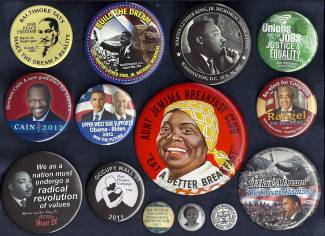Collection Name
About
"Baltimore Says Make The Dream A Reality - Jobs, Peace, Freedom." On August 27, 1983, 250,000 people attended the 20th anniversary march commemorating the August 28, 1963 March on Washington. The button shown here was made available to Baltimore, Maryland travelers to this event.
The next two buttons portray the dedication of the Martin Luther King Jr. Memorial which was held on October 16, 2011 in Washington. The dedication was originally planned for August 28, 2011 as indicated on these buttons (which were purchased on-site at the October dedication). The August dedication was cancelled due to weather concerns stemming from Hurricane Irene. The MLK memorial was authorized to be built in 1998 by a Joint Congressional Resolution signed by President William Clinton. President Barack Obama spoke at the dedication. The memorial seeks to commemorate the life and work of Dr. Martin Luther King, Jr. (1929-1968).
The Martin Luther King Jr. Memorial itself is depicted in the background of a button issued by AFSCME Maryland Council #67, a large Maryland Public Employees union. The button states that "Unions are for Jobs, Justice & Equality."
Herman Cain, a Republican, served as Chairman and CEO of Godfather's Pizza from 1986 to 1996. He unsuccessfully ran for the Republican Presidential nomination in 2000, as well as the U.S. Senate from Georgia in 2004. Cain entered the 2012 Republican Presidential Nomination primary campaign in May 2011, and dropped out of the race in December 2011.
On November 4, 2008, Barack Hussein Obama, a Democrat, became the first African-American to be elected President of the United States of America. He was re-elected to a second four-year term in the November 6, 2012 General Election. This 2012 Obama-Biden campaign button was issued in Fall 2011 by a Democratic organization located in the Upper West Side of New York City.
The genesis for "Aunt Jemima" is said to go back to an old minstrel character and song written in 1875, and which was featured in minstrel shows throughout the late 19th century. The Aunt Jemima character was used for several commercial flour and pancake mix milling companies, and was actually trademarked by one of these companies in 1893. The brand was purchased by the Quaker Oats Company in 1926 and the "Aunt Jemima" trademark registered in 1938. In the 1950s the "Aunt Jemima" logo began to come under criticism because of the negative image it portrayed of African-American women. The phrase "Aunt Jemima" was often seen or used in a derogatory sense. In this way it is portrayed as the female version of "Uncle Tom,", someone who is subservient to whites. In 1968, and again in 1989 the smiling, heavy-set African-American woman with a kerchief around her head, often seen as the "mammy" stereotype, was updated and replaced with a younger and thinner woman, with a natural hairdo and pearl necklace. The button, and "Aunt Jemima" image portrayed here was used during the 1950's and 1960's.
Charles B. Rangel, a Democrat, has served and been re-elected to the U.S. House of Representatives from 1971 to the present. This button, which portrays his image, is from his successful 2010 re-election campaign.
The Occupy Movement, which is still underway in some cities at this writing, is an international protest directed primarily against economic and social inequality. The first Occupy protest to receive wide coverage was Occupy Wall Street in New York City's Zuccotti Park, which began on September 17, 2011. Other cities, such as Baltimore soon followed, with numerous other towns across the State of Maryland, including Cumberland, joining in with smaller rallies or demonstrations. Several of the buttons used in the Wall Street Occupation invoked images and memories of Martin Luther King, Jr., including the 1968 Poor People's Campaign was organized by Martin Luther King, Jr. and the Southern Christian Leadership Council (SCLC). Its primary goal was to address issues of economic justice for the nation's poor (see Button Page #4).
During the latter part of the Nineteenth Century and into the early part of the Twentieth Century African-Americans began to organize and assert their right to teach in public schools. Pursuant to this many state "colored teachers" professional associations were formed. One of the earliest of these was in Maryland in 1886. The Maryland State Colored Teachers Association (MSCTA) had many victories throughout its existence. In 1936 the Association, in conjunction with the local chapter of the NAACP, brought suit against the Montgomery County Board of Education in order to equalize white and black teacher salaries. And by 1938 the salary schedule made no distinction by race, creed, or color. In 1937 the Maryland State Colored Teachers Association went to court "to adopt and establish salary schedules for teachers and principals in Calvert County, without distinction as to race or color of teacher." Calvert County equalized their salaries in 1939, and it is felt that this case in large part affected salary equalization across the South. (Note: The 1931 MSCTA button depicted here is an enlarged photocopy of the original which is somewhat smaller.)
The button depicting Harriet Tubman (circa 1820-1913), was part of a series of buttons from the 1970s celebrating Black History. Tubman was a former slave from Dorchester County, Maryland who would go on to lead almost 300 slaves north to freedom via the Underground Railroad.
The National Association for the Advancement of Colored People (NAACP) was founded on February 12, 1909. Originally known as the National Negro Committee, its multi-racial founders' primary purpose was to find ways to establish and promote social equality and secure for all people the rights identified within the 13th, 14th, and 15th Amendments to the United State Constitution.
The "I Have a Dream - The Dream Realized" button draws a parallel between Martin Luther King's historic "I Have a Dream" speech at the Lincoln Memorial in Washington D.C. on August 28, 1963, and Barack Obama's Presidential nomination acceptance speech on August 28, 2008 at the Democratic National Convention in Denver, Colorado.
